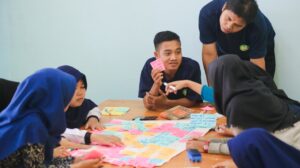The advent of social media has transformed the way individuals communicate, share information, and engage with one another. In recent years, this transformation has extended into the realm of education, where platforms such as Twitter, Facebook, Instagram, and LinkedIn are increasingly being integrated into the curriculum. Educators are beginning to recognize the potential of these platforms not only as tools for communication but also as powerful resources for enhancing learning experiences.
The integration of social media in education is not merely a trend; it represents a fundamental shift in how knowledge is disseminated and how students interact with content and each other. Social media offers a unique opportunity to bridge the gap between traditional educational methods and the digital landscape that students inhabit daily. With the majority of students actively using social media, educators have a chance to leverage these platforms to create more engaging and relevant learning experiences.
By incorporating social media into the curriculum, teachers can foster collaboration, encourage creativity, and promote critical thinking skills among students. However, this integration is not without its complexities and challenges, which necessitate a thoughtful approach to ensure that the benefits are maximized while minimizing potential drawbacks.
Benefits of Incorporating Social Media in Curriculum
One of the most significant advantages of incorporating social media into the curriculum is the enhancement of student engagement. Traditional teaching methods often struggle to capture the attention of students who are accustomed to the fast-paced, interactive nature of social media. By utilizing platforms that students are already familiar with, educators can create a more dynamic learning environment that resonates with their interests and experiences.
For instance, using Twitter for class discussions allows students to express their thoughts in real-time, fostering a sense of immediacy and relevance that can invigorate classroom dialogue. Moreover, social media facilitates collaboration among students, breaking down geographical barriers and enabling them to connect with peers from diverse backgrounds. This collaborative aspect can be particularly beneficial for group projects or discussions that require input from multiple perspectives.
For example, a history class might use a Facebook group to discuss historical events, allowing students to share articles, videos, and personal insights. This not only enriches the learning experience but also helps students develop essential skills such as teamwork and communication, which are vital in today’s interconnected world.
Challenges and Concerns of Using Social Media in Schools

Despite the numerous benefits associated with social media in education, there are significant challenges and concerns that educators must navigate. One primary concern is the issue of privacy and security. Students may inadvertently share personal information or engage in behavior that could lead to cyberbullying or harassment.
Schools must establish clear guidelines regarding acceptable use and educate students about the importance of maintaining their privacy online. Additionally, educators need to be vigilant about monitoring interactions on social media platforms to ensure a safe environment for all students. Another challenge is the potential for distraction.
While social media can enhance learning, it can also divert attention away from academic tasks. Students may find themselves scrolling through feeds or engaging in non-educational activities during class time. To mitigate this risk, educators must strike a balance between leveraging social media for educational purposes and maintaining focus on the curriculum.
This may involve setting specific times for social media use or integrating it into structured activities that keep students engaged with the learning objectives.
Case Studies of Schools Successfully Using Social Media in Curriculum
| School | Social Media Platform | Curriculum Integration |
|---|---|---|
| ABC High School | Used for real-time discussions and sharing resources in English classes | |
| XYZ Middle School | Students create visual storytelling projects for art and history classes | |
| 123 Elementary School | YouTube | Teachers upload instructional videos for science and math lessons |
Several schools have successfully integrated social media into their curricula, demonstrating its potential to enhance learning outcomes. For instance, a high school in California implemented a Twitter-based project where students were tasked with tweeting historical facts related to their coursework. This initiative not only encouraged students to research and synthesize information but also allowed them to practice concise writing skills essential for effective communication in the digital age.
The project culminated in a live Twitter chat where students engaged with historians and experts, further enriching their understanding of historical contexts. Another notable example comes from a middle school in New York that utilized Instagram as a platform for creative expression in an art class. Students were encouraged to post images of their artwork along with captions that described their creative process and inspiration.
This not only provided them with an authentic audience but also fostered a sense of community among young artists. The use of Instagram allowed students to receive feedback from peers and art enthusiasts alike, enhancing their motivation and commitment to their craft.
Strategies for Safely and Effectively Integrating Social Media in Education
To harness the benefits of social media while addressing its challenges, educators must adopt strategic approaches for integration. One effective strategy is to establish clear policies regarding social media use within the classroom. These policies should outline acceptable behavior, privacy considerations, and consequences for misuse.
By involving students in the creation of these guidelines, educators can foster a sense of ownership and responsibility among learners. Professional development for teachers is another crucial component of successful integration. Educators should receive training on how to effectively use social media tools in their teaching practices while understanding the potential risks involved.
Workshops can provide teachers with practical strategies for incorporating social media into lesson plans, as well as insights into best practices for monitoring student interactions online. Additionally, schools can create support networks where teachers can share experiences and resources related to social media integration.
The Role of Teachers and Administrators in Utilizing Social Media in Curriculum

Teachers and administrators play pivotal roles in the successful integration of social media into educational settings. Teachers are at the forefront of this initiative; they must be equipped not only with the technical skills necessary to navigate various platforms but also with pedagogical strategies that align social media use with learning objectives. By modeling appropriate online behavior and demonstrating how to engage constructively on social media, teachers can guide students toward responsible usage.
Administrators also have a critical role in fostering an environment conducive to social media integration. They must support teachers by providing resources, training opportunities, and access to technology that facilitates social media use in classrooms. Furthermore, administrators should actively engage with parents and guardians to communicate the benefits and guidelines surrounding social media use in education.
By building a collaborative relationship with families, schools can create a supportive network that reinforces positive online behavior among students.
The Impact of Social Media on Student Engagement and Learning Outcomes
Research indicates that when used effectively, social media can significantly enhance student engagement and improve learning outcomes. Engaged students are more likely to participate actively in their education, leading to deeper understanding and retention of material. For instance, studies have shown that classes utilizing social media platforms for discussions often see increased participation rates compared to traditional classroom settings.
This heightened engagement can lead to improved academic performance as students feel more connected to their peers and invested in their learning. Moreover, social media encourages self-directed learning by providing students with access to a wealth of information beyond traditional textbooks. Platforms like YouTube offer instructional videos on virtually any topic imaginable, allowing students to explore subjects at their own pace.
This autonomy fosters critical thinking skills as students learn to evaluate sources and synthesize information from various perspectives. As they engage with diverse content online, students develop a more nuanced understanding of complex issues, preparing them for future academic challenges.
The Future of Social Media in Education
As we look toward the future of education, it is clear that social media will continue to play an increasingly prominent role in shaping teaching and learning experiences. The ongoing evolution of technology will likely introduce new platforms and tools that educators can leverage to enhance student engagement further. However, this evolution will also necessitate ongoing discussions about best practices for safe and responsible use.
The future will require educators to remain adaptable and open-minded as they navigate the complexities of integrating social media into their curricula. By fostering a culture of collaboration among teachers, administrators, students, and parents, schools can create an environment where social media serves as a powerful ally in education rather than a distraction or source of concern. Ultimately, embracing social media as an educational tool has the potential to enrich learning experiences and prepare students for success in an increasingly digital world.
FAQs
What is social media?
Social media refers to websites and applications that allow users to create and share content or to participate in social networking.
How are schools currently using social media in the curriculum?
Schools are using social media in the curriculum to teach digital literacy, online safety, and responsible social media use. Some educators also use social media platforms to engage students in discussions and share educational resources.
What are the potential benefits of using social media in the curriculum?
Potential benefits of using social media in the curriculum include increased student engagement, improved communication between students and teachers, and the opportunity to teach digital citizenship skills.
What are the potential risks of using social media in the curriculum?
Potential risks of using social media in the curriculum include cyberbullying, privacy concerns, and the potential for distraction from academic work.
How can schools mitigate the risks of using social media in the curriculum?
Schools can mitigate the risks of using social media in the curriculum by implementing clear guidelines for social media use, providing education on online safety and privacy, and monitoring students’ online activity.
What are some examples of social media platforms that schools may use in the curriculum?
Examples of social media platforms that schools may use in the curriculum include Twitter, Facebook, Instagram, and educational platforms such as Edmodo or Google Classroom.
What do experts say about using social media in the curriculum?
Experts have varying opinions on using social media in the curriculum. Some believe that it can be a valuable tool for teaching digital literacy and engaging students, while others have concerns about the potential risks and distractions.



